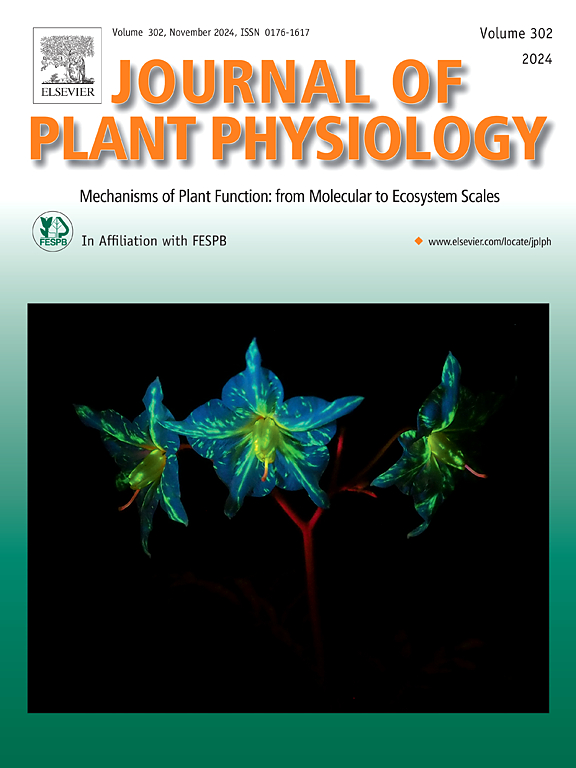High throughput phenotyping using automated imaging system reveals the relationship between seed yield and agronomic traits in Korean rice cultivars
IF 4.1
3区 生物学
Q1 PLANT SCIENCES
引用次数: 0
Abstract
This study utilized plant phenomics image analysis technology to explore the agronomic characteristics of rice cultivars, aiming to enhance growth stability, yield potential, and digital data for rice breeding. RGB images were captured at three lateral angles during the growth period of the plants using ScanLyzer, LemnaTec. A total of 42 agronomic traits were analyzed across 102 rice cultivars, categorized into three maturing groups. In addition, to evaluate the measurement accuracy, 9 phenotypic traits, the panicle length (Pl), panicle count (Pc), and number of seeds were also measured destructively after harvest. Parameter estimated revealed that the Pl trait exerted the strongest positive effect on seed production across all groups analyzed, with coefficients (β) of 0.459 for the entire population, 0.456 in the early-maturing group, 0.537 in the medium-maturing group, and 0.574 in the medium-late maturing group (p < 0.05). Other traits, such as maximum area (Am), and maximum height (Hm), also positively influenced seed production but to a lesser extent. Notably, duration of maximum value of rice plant width had a significant negative effect in the early-maturing group (β = -0.369, p < 0.05). Correlation analyses revealed strong positive relationships between seed production and various traits across maturity classes, notably with days to maximum height, Pl, Pc, and seed count. Additionally, panicle length and count emerged as pivotal factors influencing seed numbers. These findings underscore the varying impacts of agronomic traits on seed yield depending on cultivars and maturity groups, offering valuable insights for the selection of rice cultivars aimed at optimizing seed production.
利用自动成像系统进行高通量表型分析,揭示了韩国水稻品种籽粒产量与农艺性状之间的关系
本研究利用植物表型组学图像分析技术探索水稻品种的农艺性状,旨在提高水稻的生长稳定性和产量潜力,并为水稻育种提供数字化数据。使用ScanLyzer, LemnaTec在植物生长期间从三个侧面角度拍摄RGB图像。对102个水稻品种的42个农艺性状进行了分析,将其分为3个成熟类群。此外,为了评估测量的准确性,还在收获后对9个表型性状、穗长(Pl)、穗数(Pc)和种子数进行了破坏性测量。参数估计表明,Pl性状对种子产量的正向影响在各分析组中最强,全群体的系数(β)为0.459,早熟组为0.456,中熟组为0.537,中晚熟组为0.574 (p <;0.05)。其他性状如最大面积(Am)和最大高度(Hm)对种子产量也有正向影响,但影响程度较小。值得注意的是,水稻株宽最大值持续时间对早熟组有显著的负影响(β = -0.369, p <;0.05)。相关分析表明,种子产量与各成熟等级的各项性状呈显著正相关,特别是与最大高度日数、Pl、Pc和种子数呈正相关。此外,穗长和穗数是影响种子数量的关键因素。这些发现强调了农艺性状对种子产量的不同影响取决于品种和成熟度组,为以优化种子产量为目标的水稻品种选择提供了有价值的见解。
本文章由计算机程序翻译,如有差异,请以英文原文为准。
求助全文
约1分钟内获得全文
求助全文
来源期刊

Journal of plant physiology
生物-植物科学
CiteScore
7.20
自引率
4.70%
发文量
196
审稿时长
32 days
期刊介绍:
The Journal of Plant Physiology is a broad-spectrum journal that welcomes high-quality submissions in all major areas of plant physiology, including plant biochemistry, functional biotechnology, computational and synthetic plant biology, growth and development, photosynthesis and respiration, transport and translocation, plant-microbe interactions, biotic and abiotic stress. Studies are welcome at all levels of integration ranging from molecules and cells to organisms and their environments and are expected to use state-of-the-art methodologies. Pure gene expression studies are not within the focus of our journal. To be considered for publication, papers must significantly contribute to the mechanistic understanding of physiological processes, and not be merely descriptive, or confirmatory of previous results. We encourage the submission of papers that explore the physiology of non-model as well as accepted model species and those that bridge basic and applied research. For instance, studies on agricultural plants that show new physiological mechanisms to improve agricultural efficiency are welcome. Studies performed under uncontrolled situations (e.g. field conditions) not providing mechanistic insight will not be considered for publication.
The Journal of Plant Physiology publishes several types of articles: Original Research Articles, Reviews, Perspectives Articles, and Short Communications. Reviews and Perspectives will be solicited by the Editors; unsolicited reviews are also welcome but only from authors with a strong track record in the field of the review. Original research papers comprise the majority of published contributions.
 求助内容:
求助内容: 应助结果提醒方式:
应助结果提醒方式:


